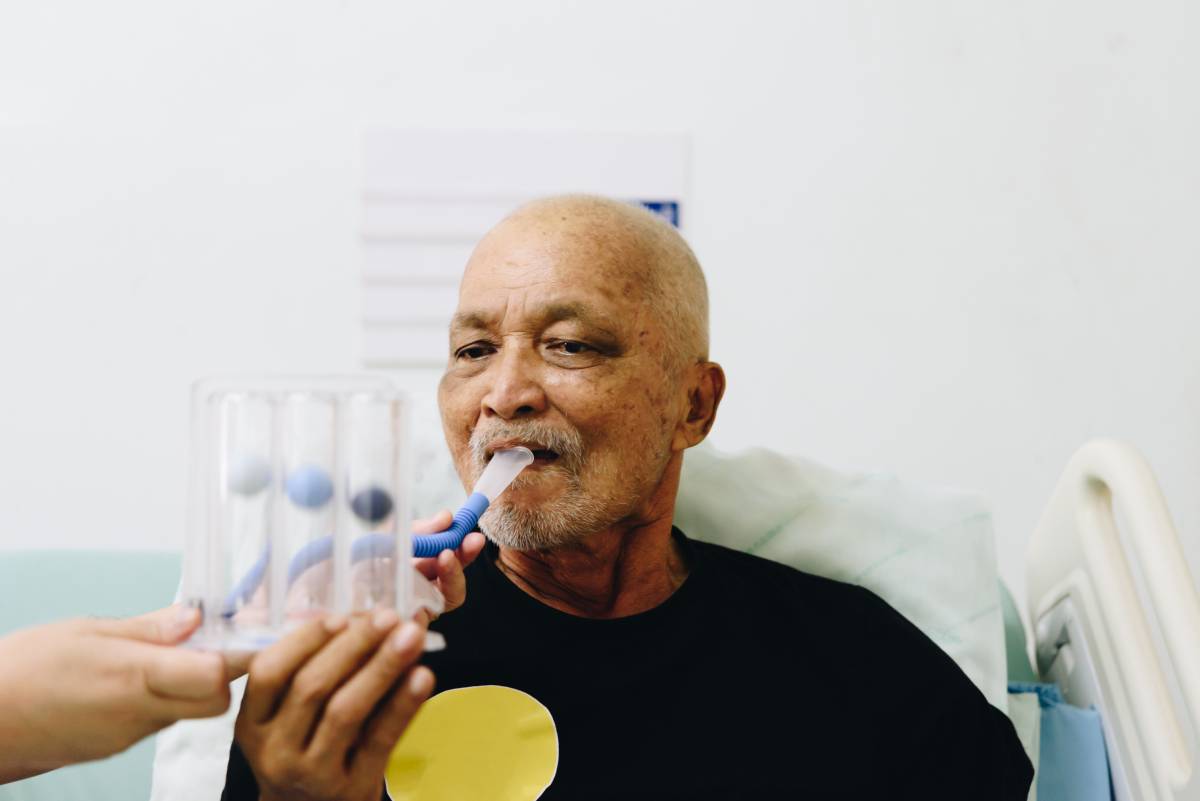Inspiratory Muscle Training

Inspiratory muscle training (IMT) involves breathing exercises using a pressure threshold device to strengthen the muscles involved in breathing in [1]. IMT is safe and has not been shown to adversely affect patients’ heart rate, mean arterial pressure, or oxygen saturation measurements [5]. It is a technique that has been widely applied to different populations, especially the general population of older adults [2]. IMT is a promising tool for overall health management and has been reported to improve exercise capacity, functional anatomy, diaphragmatic thickness and mobility, and cardiac autonomic control [2].
Aging is associated with biological changes that compromise inspiratory muscle function and lung structure [1]. It is reported that the strength of the inspiratory muscles declines gradually from 65 years of age onwards [1]. Reduced respiratory strength has been identified as a risk factor for poor prognosis and mortality in many diseases [2]. In older adults, there is an association between reduced respiratory muscle strength and diminished physical performance [2]. Moreover, reduced respiratory strength is an independent risk factor for myocardial infarction and cardiovascular disease [2]. A 2020 study sought to determine the isolated effects of IMT on general parameters of health in older adults (> 60 years) independently of their health condition [2]. The results of the study revealed that IMT contributes to increasing the inspiratory muscle strength in older adults [2]. In a separate 2019 study also focusing on the impact of IMT in older populations, IMT was associated with enhanced balance performance, which would reduce the likelihood of fatal and nonfatal injuries [1].
IMT has also been shown to improve the quality of life for people with heart failure [3]. This disease causes a reduction in cardiac output and blood flow to the peripheral and respiratory muscles [3]. The resulting muscle weakness is often associated with dyspnea, fatigue, reduced functional capacity, and increased exercise intolerance [3]. IMT has been recommended as a therapy to improve cardiopulmonary capacity in patients with heart failure [3]. The results of a 2020 study found that IMT increases inspiratory muscle strength, functional capacity, and quality of life in patients with heart failure [3]. Notably, the benefits of IMT therapy were seen most in patients who used training loads higher than 60% and who had longer intervention times [3].
Respiratory muscle weakness is also observed in chronic obstructive pulmonary disease (COPD), and IMT has been associated with improvement in respiratory muscle functioning [4]. COPD can lead to hypercapnia, dyspnea, nocturnal oxygen desaturation, and reduced exercise capacity [4]. A meta-analysis of 18 studies revealed substantial evidence supporting the application of IMT in the treatment of COPD patients [4]. Statistically significant improvements were observed for inspiratory muscle strength, endurance, functional capacity, dyspnea, and quality of life [4]. The improvement in inspiratory muscle endurance capacity is thought to be due to an increase in the proportion of type I muscle fibers and the size of type II muscle fibers in the external intercostals, the muscles between the ribs, after IMT [4].
References
- Ferraro, F., Gavin, J., Wainwright, T., & McConnell, A. (2019). The effects of 8 weeks of inspiratory muscle training on the balance of healthy older adults: a randomized, double‐blind, placebo‐controlled study. Physiological Reports, 7(9), e14076. doi:10.14814/phy2.14076
- Seixas, M., Almeida, L., Trevizan, P. et al. (2020). Effects of inspiratory muscle training in older adults. Respiratory Care, 65(4), 535-544. doi:10.4187/respcare.06945
- Azambuja, A., de Oliveira, L., & Sbruzzi, G. (2020). Inspiratory Muscle Training in Patients with Heart Failure: What Is New? Systematic Review and Meta-Analysis. Physical Therapy, 100(12), 2099-2109. doi:10.1093/ptj/pzaa171
- Gosselink, R., De Vos, J., Van Den Heuvel, S. et al. (2011). Impact of inspiratory muscle training in patients with COPD: what is the evidence?. European Respiratory Journal, 37(2), 416-425. doi:10.1183/09031936.00031810
- Tonella, R., Ratti, L., Delazari, L. et al. (2017). Inspiratory muscle training in the intensive care unit: a new perspective. Journal of Clinical Medicine Research, 9(11), 929. doi:10.14740/jocmr3169w
